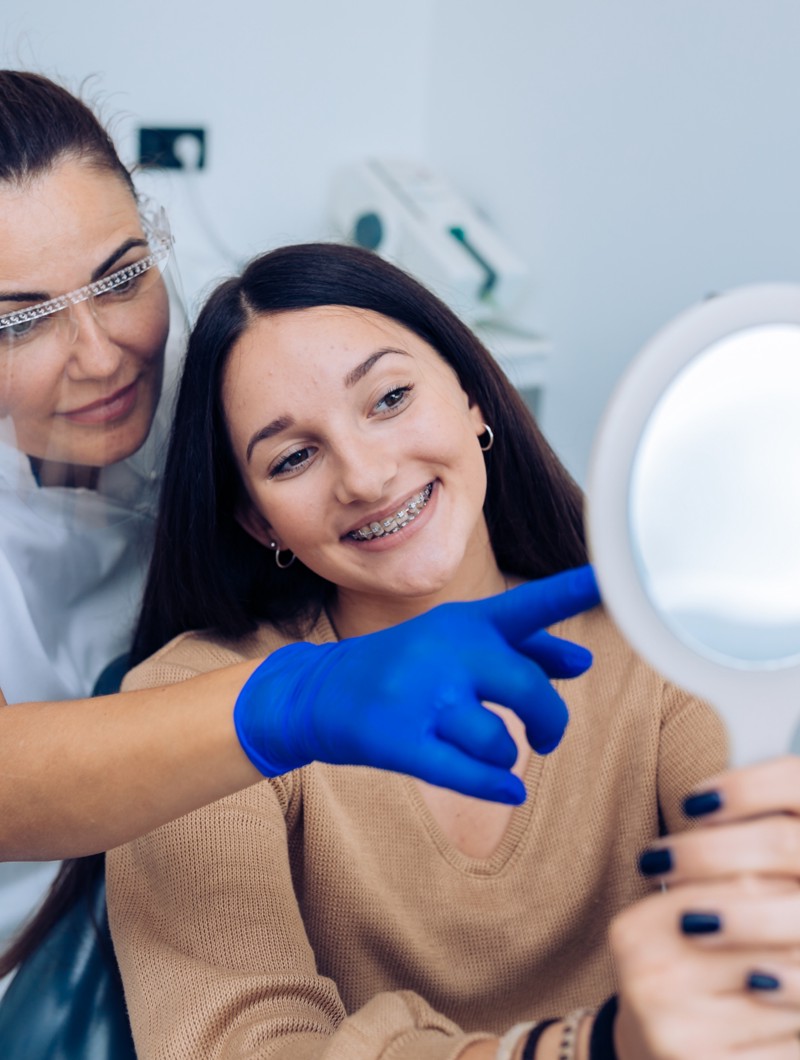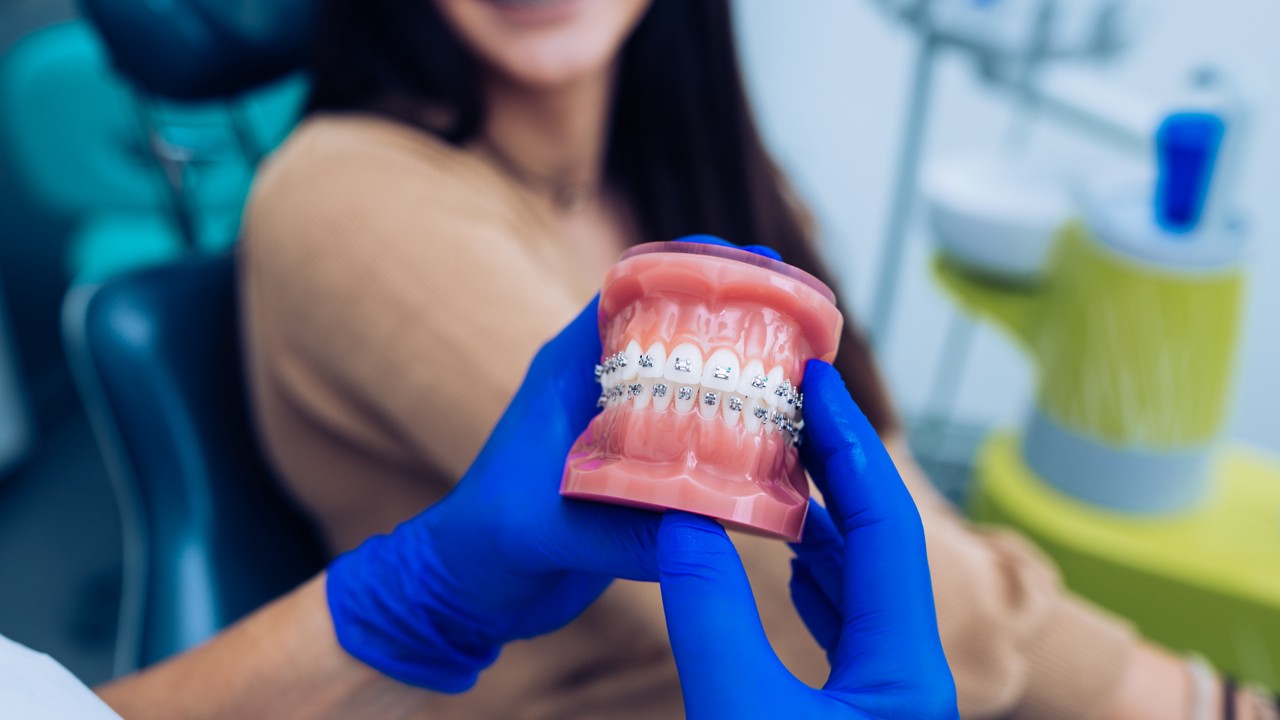Fixed orthodontic appliances
Orthodontic treatment corrects the incorrect position of the teeth and the jaw relation.


What is an orthodontic treatment and when is it used?
Orthodontic treatment is a type of treatment that involves wearing braces. This solves problems such as gaps between the teeth (closing the holes), incorrect tooth position, difficulty in chewing, slurred speech, bad bite, lack of teeth in the jaw, and impacted teeth.
Dental braces are divided into 2 main categories: mobile (including Invisalign treatment), which can be removed, and fixed braces, which cannot be removed without the help of an orthodontist. The decision between fixed and mobile braces is after a detailed examination and consultation with the orthodontist.
Who needs fixed orthodontic appliance?
- Patients who are not satisfied with their smile and want to straighten their teeth
Modern orthodontic treatment is applicable and successful at any age, especially if the bone and gum structure is good.
Despite the common belief that the sole goal of orthodontics is the beauty of the teeth, it is also worth noting its key role in maintaining the health of the chewing system, the jaw joint and muscles, as well as the surrounding dental tissue.

Frequently asked questions
What types of brackets are there?
At Dentum, you can choose between classic metal brackets and tooth-colored ceramic brackets. We also offer gold (iconic) brackets and mini brackets, which are smaller than the classic ones. We keep up with the latest trends in the world of fixed orthodontics, constantly introducing new materials and techniques into our offer.
In addition to these types of braces, we also offer a special method of fixed orthodontics called Six Month Smiles. These are also braces, but more transparent and less noticeable on the teeth. The Six Month Smiles method is intended for minor orthodontic irregularities, and the treatment lasts from four to nine months, six on average.
Which type of orthodontics is the best?
There is no answer to the question of which type of orthodontics is the best, because each can correct major irregularities. It can be said that fixed orthodontic appliances are more adequate for adolescents than corrective splints since wearing splints requires a special responsibility of the patient. It is necessary to wear them 22/24 hours a day and to replace them regularly every 2 weeks. Corrective splints are more often chosen by adults who do not want to wear braces.
What is a fixed brace?
Fixed braces, as its name suggests, cannot be removed without the help of an orthodontist. Fixed braces essentially consist of brackets and a wire, where part of the information about where the tooth should go is written in the brackets, and part in the wire. Braces are attached to the teeth and interconnected by a wire and, based on the information, “force” the teeth in the desired direction.
Is orthodontic treatment always the first choice?
There are also cases where orthodontic treatment is not the first choice. For example, in cases where in the upper jaw the front teeth are small and spaced, and the rest of the jaw is in a correct relation. Orthodontic appliance can close the diastema, but these teeth remain small. In this case, a better choice is prosthetics - ceramic veneers or zircon crowns. Each case is different and we always recommend coming for an examination to assess the condition.
Why do I need an orthodontist for braces?
Not every dentist is an orthodontist, so when you want to correct your teeth, contact a specialist - an orthodontist.
What is the difference between metal and transparent (white) fixed braces?
The only difference is in the type of material. Faster results are achieved with treatment using metal brackets and metal wire (on average 3 months faster) than with transparent fixed braces. The most important thing is to consult with an orthodontist before deciding on the type of braces in order to match your wishes and possibilities.
What is the best age to wear braces?
According to the American Board of Orthodontics, the first orthodontic examination is recommended at the age of 6. Depending of the patient's age, it is decided whether to deal with habits such as finger-sucking, lip biting, etc. or whether to start orthodontic treatment with braces. The best time will be determined by the orthodontist after an examination. The younger the patient, the shorter the treatment, and the more long-term the results. The recommendation of the orthodontists is not to delay the examination!
What should I pay attention to when eating if I wear fixed braces?
In order not to break the braces parts (wire, brackets, rings), patients wearing fixed braces should pay attention to the type of food and the way they consume it. According to research, every time you break a part of the brace, the duration of treatment is extended by a month. That is why you should be careful when eating and avoid tearing food with your teeth, use fork and knife. Foods to be more careful with while wearing braces include:
- dry and hard fruits (do not bite the apple, but cut it into smaller pieces),
- chewing gum and candies,
- all kinds of nuts (almonds, hazelnuts, walnuts),
- hard pastries and bread crusts,
- pieces of ice,
- meat (cut it into smaller pieces).
Is removing braces painful?
Removing fixed braces does not hurt, but patients can feel a little discomfort when removing brackets from their teeth. The process of removing braces does not take long, and patients rarely experience problems during the removal.
Do children need orthodontic treatment?
In childhood, orthodontic anomalies are most often associated with inappropriate habits which are addressed in children between ages 6 and 10. These are normal habits in young children, but the problem arises when people continue with such habits as adults. In this case, it is much more difficult to get rid of them and it is necessary to wear fixed braces in addition to some other therapeutic approaches.

“Fixed orthodontics at Dentum is a completely individualized treatment for correcting the position of the teeth, achieving ideal aesthetics, and with the help of maxillofacial surgery and complete correction of the jaws, changing the face appearance.”
Katarina Krajačić, DMD, Specialist in Orthodontics
Fixed orthodontics